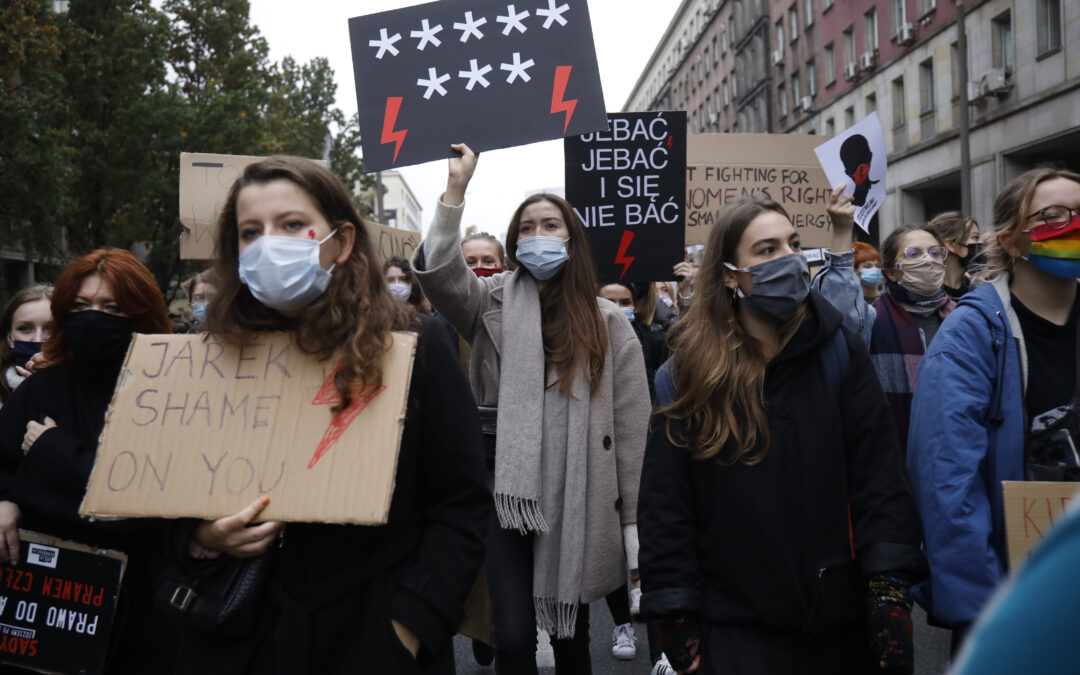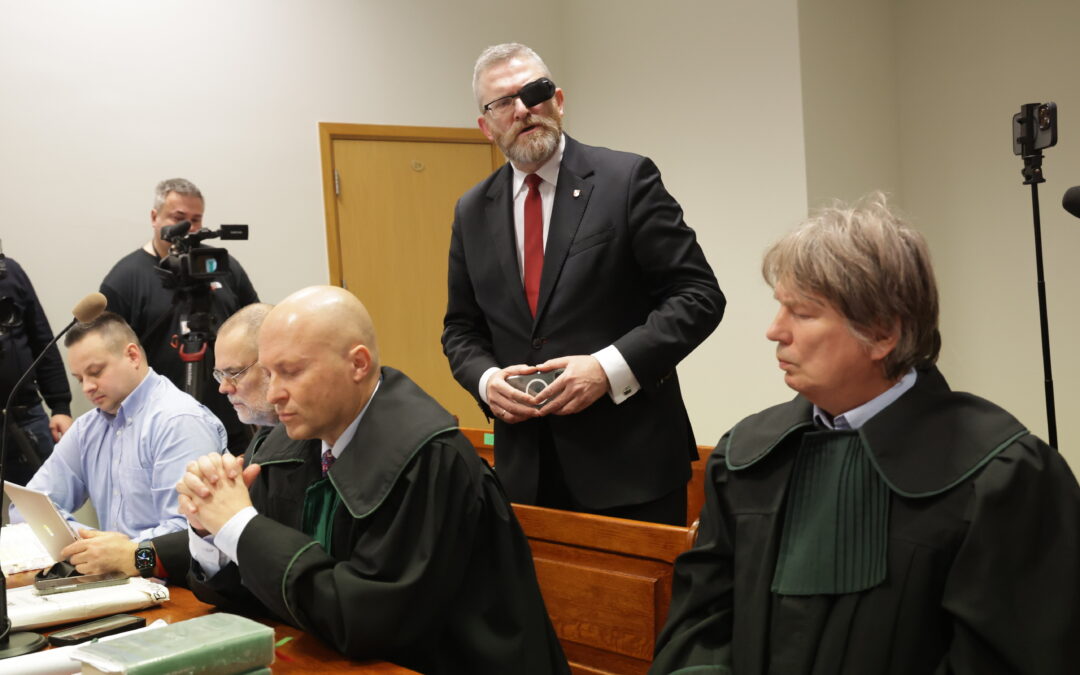By Agnieszka Wądołowska
Since last week’s constitutional court ruling that introduces a near total ban on abortion in Poland, the country has witnessed eight consecutive days of mass protests that are believed to be the largest since the fall of communism in 1989.
Much of the demonstrators’ anger has been directed not against the court itself, but rather towards the Catholic church and ruling national-conservative Law and Justice (PiS) party, who are seen as being behind the ruling.
As hundreds of thousands of people have taken to the streets, many have displayed symbols that have come to characterise the protests. Below, we explain the meaning and history behind six of the most common.
Red lightning bolt
A red lightning bolt has become the main symbol of the protests. It is part of the logo of Women’s Strike (Strajk Kobiet), a grassroots women’s rights initiative and the main organiser of the current demonstrations.
It was originally created by graphic designer Ola Jasionowska, who says that it symbolises a warning. “It says: watch out, beware, we won’t accept that women are being deprived of their basic rights,” Jasionowska explained to Newsweek Polska.
Nigdy już żadna nie będzie szła sama. Będziemy szły razem. Będziemy walczyć o polskie kobiety i przestrzeganie praw człowieka – na ulicy i w sejmie. Marszałek Terlecki albo się z tym pogodzi i wprowadzi pod obrad ustawę o depenalizacji i legalizacji, albo będzie miał rewolucję! pic.twitter.com/PsiH9cvJM7
— Marcelina Zawisza (@mmzawisza) October 27, 2020
The symbol has been seized upon by critics of the protests, who have tried to claim that it is similar to the insignia used by the SS and other formations in Nazi Germany.
Ryszard Terlecki, head of PiS’s parliamentary caucus and deputy speaker of the lower house of parliament, said it was “sad” to see opposition MPs wearing facemasks “referencing totalitarian symbols”.
News broadcasts on state TV, which is under the influence of PiS, have this week repeatedly referred to the protesters as “left-wing fascists” and drawn links between their symbol and Nazism.
"Leftist fascism is destroying Poland" headlined the main evening news on state TV (a government mouthpiece) for the second night in a row.
They said that abortion protesters have expressed "approval of cannibalism" and use a symbol associated with Nazism and Satan pic.twitter.com/8Xufk66tih
— Daniel Tilles (@danieltilles1) October 28, 2020
Supporters of the protests point out that the Women’s Strike logo is different in colour, shape and style to the SS insignia, and that lightning bolts are a common symbol for an array of different groups.
Among those that have used such as symbol were the “Grey Ranks”, an underground Polish paramilitary organisation that resisted the German Nazi occupation in World War II. Those who link the lightning symbol to Nazism are “insulting Polish heroes”, said left-wing MP Anna-Maria Żukowska.
Jasionowska, the designer of the logo, says the claims of Nazi links are “absurd”: “It wasn’t my intention at all. Everyone looks for interpretations that they find useful.”
“Wypierdalać” and Solidarity
One of the main slogans of the current protests has been “Wypierdalać”, a vulgarity that translates roughly as “Fuck off”.
The word has been chanted by demonstrators, while also appearing on posters and banners. Some quickly began to combine it with an iconic Polish symbol of protests and resistance, the logo of the Solidarity (Solidarność) trade union that played a leading role in bringing down communism in Poland in the 1980s.
A court ruling that introduces a near total ban on abortion in Poland has brought tens of thousands of protesters – mostly women – onto the streets.
We look at the protests through the lens of Italian photographer Luca Aliano https://t.co/EkqNxOnSrZ
— Notes from Poland 🇵🇱 (@notesfrompoland) October 26, 2020
Artist Jarek Kubicki then developed that theme further by adapting a famous campaign poster from 1989, when Poland held its first semi-free elections, in which the Solidarity logo appeared behind an image of Gary Cooper appearing as a cowboy in the American Western High Noon.
Kubicki recreated the poster, but with “Solidarność” replaced by “Wypierdalać” and Gary Cooper replaced by female action heroes from Hollywood movies.
The idea quickly spread, with many Polish women, including left-wing female MPs, creating similar images with themselves in the foreground.
The designer of the original Solidarity logo, Jerzy Janiszewski, has previously said that he has no problem with abortion protesters using his work.
“As the author, I am opposed to prosecuting and punishing anyone for using the logo during peaceful and, in my opinion, legitimate protests for women’s rights in Poland,” he said in 2016.
***** ***
At the abortion protests, there have been many signs bearing eight asterisks in the form ***** ***, in what may be a rather confusing and cryptic message for observers from outside Poland. The symbols (widely referred to as “eight little stars” in Polish) stand for “Jebać PiS” (Fuck PiS).
They became a widely used meme during this year’s presidential election campaign, especially after they appeared in the video for a song by Polish rapper Taco Hemingway that was seen as critical of the ruling party.
In one famous image, President Andrzej Duda – who was standing for re-election as the candidate supported by PiS – unwittingly posed for a photo alongside a young man wearing a t-shirt bearing the eight stars.
Chyba nikt prezydenta nie pilnuje na tych wiecach. Ale że on sam nie wie, co oznacza osiem gwiazdek? Bronkizacji PAD ciąg dalszy. IMHO ma dużo szczęścia, że wybory już w niedzielę pic.twitter.com/RGu9sojAq3
— Michał Płociński (@michalplocinski) July 10, 2020
During the current protests, “Jebać PiS” has become a widespread slogan, appearing on banners (often now without the censorship of asterisks) and being chanted to the tune of songs such as Eric Prydz’s “Call On Me”.
Around a thousand abortion protesters held a party outside the ruling party's HQ in Warsaw, singing "Jebać PiS" (Fuck PiS) to the tune of "Call On Me" by @ericprydz pic.twitter.com/yU9kRLP95e
— Daniel Tilles (@danieltilles1) October 26, 2020
Black umbrella
In 2016, mass protests also took place against an attempt to tighten the abortion law and delegalise prenatal screening. Tens of thousands of Polish women, wearing black to symbolise mourning, came out onto the streets.
Some of the largest demonstrations took place in the autumn rain, and as a result umbrellas became a symbol of the “Black Protests”.
Thousands Of Pissed Off Women
Warsaw (City in Europe)
October 2016 (AD)#czarnyprotest#blackprotest pic.twitter.com/7SfEPJZ7PO— Borys Musielak (@michuk) October 3, 2016
Those demonstrations succeeded in forcing PiS to back away from the proposed abortion ban. But afterwards, organisers vowed: “Nie składamy parasolek” (We’re not closing our umbrellas). And since then, umbrellas have reappeared whenever a threat to women’s reproductive rights is perceived.
Earlier this year, another proposal to ban abortion returned to parliament during lockdown. With street protests prohibited, many women placed black umbrellas in their windows or balconies, or held black umbrellas while queuing outside of shops.
Jak zaprotestować, nie ruszając się z domu? Oto, co możesz zrobić. Kiedy zaczynamy? TERAZ! A NAJPÓŹNIEJ WE WTOREK! #StopBarbarzyńcom #PiekłoKobiet #PolskiePiekło #StrajkKobiet Więcej na stronie @strajkkobiet pic.twitter.com/qrR3i7IuOe
— Bożena Przyłuska (@BozenaPrzyluska) April 12, 2020
During the current protests – which are also taking place amid tightened coronavirus restrictions, including limits on the size of gatherings – some women have met for “walks with umbrellas”.
With new coronavirus restrictions on gatherings going into force today, women in Poznań protested the anti-abortion ruling by going for a "walk with umbrellas".
It's not raining: umbrellas are in Poland a symbol of protests against restricting abortion https://t.co/I5KDbfCXl4
— Notes from Poland 🇵🇱 (@notesfrompoland) October 24, 2020
Coat hanger
Coat hangers – an international symbol of pro-choice protests – have also been widespread during the current demonstrations in Poland, being both wielded by the protesters themselves and also hung on the doors or fences of churches and offices of right-wing politicians.
The demonstrations taking place in the city of Wrocław last Saturday were called the “Night of the Coat Hanger” (Noc wieszaka). Protesters “decorated” the gate of the palace of the archbishop of Wrocław with slogans and coat hangers as well as a chemise stained with blood.
.@ZieloniWro jak zawsze tam gdzie trzeba✊💚 Dziś wspólnie z wrocławiankami i wrocławianami licznie spacerowali po Ostrowie Tumskim. Ktoś by powiedział, że pod prawdziwą siedzibą PiS we Wrocławiu. Nie pozwolimy odebrać sobie naszych praw❗ #OstraJazda #StrajkKobiet #PiekłoKobiet pic.twitter.com/d23pT8REnW
— Małgorzata Tracz (@GoTracz) October 24, 2020
The symbol refers to the dangers women face if they are forced to seek illegal, backstreet abortions due to the lack of availability of safe legal ones.
In Poland, which has the strictest abortion law in the EU other than Malta’s, only around 1,000 legal abortions take place each year. But it is estimated that tens of thousands of women have illegal terminations annually, while many travel abroad for procedures in countries with more liberal laws.
Artist Iness Rychlik has produced a self-portrait combining the coat hanger symbol with a blood stain in the shape of Poland. Her work is entitled Granice subtelności, with granice meaning both “limits” and “borders” and subtelności meaning “of subtlety” or “of nicety”.
The “PW” Anchor
The “anchor” (kotwica) is one of Poland’s most important symbols. Created in 1942 by Anna Smoleńska, a member of the underground resistance, it was used as an emblem of the struggle against German occupation during the war. Its shape creates the letters “PW”, standing for Polska Walcząca (Poland Fighting).
The ‘Kotwica” sign – the emblem of #FightingPoland – was created in 1942 as a symbol of resistance against German occupation of Poland.#PolishUndergroundState #OccupiedPoland #WWII #WW2 #HomeArmy #Polishhistory #Kotwica pic.twitter.com/boUE5eL2QQ
— Institute of National Remembrance (@ipngovpl_eng) January 17, 2019
During the Black Protests of 2016, some women displayed an adapted version of the symbol, turning the arms of the anchor into breasts and making the PW stand for Polka Walcząca (Polish Woman Fighting).
Transparent z "Polką Walczącą" nie był zniewagą. Młoda kobieta uniewinniona przez sąd https://t.co/weRsXgqMEn pic.twitter.com/bIOObfcoMC
— Wyborcza.pl Szczecin (@GW_Szczecin) February 18, 2017
The original anchor symbol was worn by PiS leader Jarosław Kaczyński on his lapel this week, when he gave an address warning that the abortion protesters were seeking to “destroy Poland”. He called on his supporters to “defend patriotism” by “winning the war declared by our opponents”.
Main image credit: Maciek Jazwiecki / Agencja Gazeta

Agnieszka Wądołowska is deputy editor-in-chief of Notes from Poland. She is a member of the European Press Prize’s preparatory committee. She was 2022 Fellow at the Entrepreneurial Journalism Creators Program at City University of New York. In 2024, she graduated from the Advanced Leadership Programme for Top Talents at the Center for Leadership. She has previously contributed to Gazeta Wyborcza, Wysokie Obcasy and Duży Format.




















